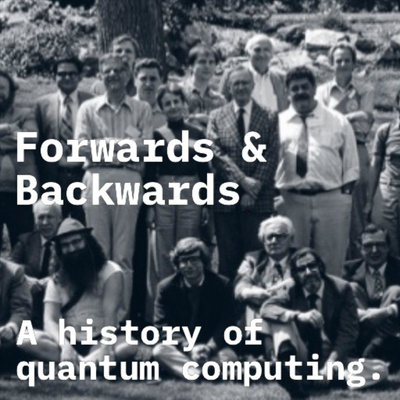
Forwards & Backwards: A History of Quantum Computing
By Sebastian Hassinger

Forwards & Backwards: A History of Quantum Computing May 05, 2021

6 - Taking A Long Look Backwards (...and Forwards)
When we set out to produce this series, there was one name we heard more frequently than any other: Charlie Bennett.
Charlie is one of the founding fathers of quantum information theory; a physicist, an information theorist, and an IBM Fellow; the photographer behind the famous picture captured at the Endicott House conference 40 years ago; and a visionary without whom we would be staring down a very different quantum future.
Sebastian, Abe and Matt sit down for a conversation with Charlie about the rise of reversible computing, the limits of anthropocentrism in quantum information science, and the importance of broadening peoples’ intuition in order to bring about seismic change.
Credits: Co-created and co-hosted by Sebastian Hassinger and Abraham Asfaw. Produced, written, co-hosted and edited by Matt Hooper. Special thanks to the entire IBM Quantum team.

5 - Putting Today's Quantum Systems to Good Use
Real quantum computers are here, but they are small and noisy, and not fully mature. Be that as it may Professor Prineha Narang of Harvard is finding ways to use IBM’s open-source quantum platforms to do useful things like simulation and probing the limits of what is possible right now. Additionally, she is pioneering ‘Quantum Entanglement as a Service’ via her startup, Aliro, a software company whose goal is to democratize access to quantum computing.
Join Sebastian and Matt as they chat with Prineha about her own quantum journey, the power and problems of quantum noise, and the development of both her class and business.
Credits: Co-created and co-hosted by Sebastian Hassinger and Abraham Asfaw. Produced, written, co-hosted and edited by Matt Hooper. Special thanks to the entire IBM Quantum team.

4 - Very Cold Qubits for a Very Hot Community
Sometimes, you just want to experience a very large dilution refrigerator in action. And that’s exactly what this episode delivers!
Join Sebastian, Abe and Matt as they chat with Pat Gumann (Manager of Quantum Processor and System Integration, Quantum Computing at IBM) and Jay Gambetta (IBM Fellow and Vice President, Quantum Computing at IBM), about how the quantum field became a quantum industry, and the technical challenges of using a superconducting platform to build qubits.
Credits: Co-created and co-hosted by Sebastian Hassinger and Abraham Asfaw. Produced, written, co-hosted and edited by Matt Hooper. Special thanks to the entire IBM Quantum team.

3 - Who Works On this Stuff? And How Can We Expand The Field?
We’ve often referenced the cross-disciplinary nature of the quantum computing field. Nowhere is that clearer than in the stories of three of our guests, each of whom are professors at esteemed universities, and each of whom are propelling the field forward. Margaret Martonosi, the head of the Directorate for Computer and Information Science and Engineering at the National Science Foundation and a Professor of Computer Science at Princeton University; Tina Brower-Thomas, Principal Investigator for Integrated Quantum Materials and Director for the Integration for the NSF at Howard University; and Ken Brown, Professor in the Department of Electrical and Computer Engineering.
Join Sebastian, Abe and Matt as they sit down with each of these QC leaders to discuss the downturn in quantum funding in the early 2000’s, the trapped ion vs superconducting debate, and the opportunity to build a more inclusive workforce in the 2020’s.
Credits: Co-created and co-hosted by Sebastian Hassinger and Abraham Asfaw. Produced, written, co-hosted and edited by Matt Hooper. Special thanks to the entire IBM Quantum team.

2 - Quantum Computing Has A Purpose! (The Factoring Algorithm)
In the mid-90’s, there was no quantum computing field. There was excitement, sure, but nearly a decade and a half after the conference at MIT Endicott House, the possibilities of marrying physics and computer science had yet to yield a significant technological breakthrough.
That is, until Peter Shor discovered a way to break RSA, the most famous public-key cryptosystem.
Shor’s Algorithm was more than a call to action for a generation of scientists, it was a glimpse of how much faster a quantum machine would be able to crack even the most complex encryption scheme. Sebastian, Abe and Matt sit down with Peter Shor to discuss the discovery of the algorithm, the extraordinary response his work received twenty-five years ago, and what’s next for ensuing generations of scientists and information theorists.
Credits: Co-created and co-hosted by Sebastian Hassinger and Abraham Asfaw. Produced, written, co-hosted and edited by Matt Hooper. Special thanks to the entire IBM Quantum team.

1 - Dawn of a Quantum Era
On May 6th, 1981, at the MIT Endicott House, a group of computer scientists gathered together with elite physicists to make the case that quantum phenomena could be used for computation.
Here, ideas that would influence the next four decades of quantum computing research and development first took root, as a new wave of interdisciplinarians asked themselves: what lies beyond the 0’s and 1’s? In other words, if classical computing represented binary calculations, how could quantum computing represent calculations using the math of the universe?
Sebastian Hassinger (IBM Quantum Research and Ecosystem Partnerships), and Abraham Asfaw (Global Lead, Quantum Education and Open Science at IBM Quantum) join host Matt Hooper in conversation with historian Susannah Glickman to learn about the forces and figures that transformed quantum information theory from a literal back-of-the-napkin idea into the next wave of computing.
Credits: Co-created and co-hosted by Sebastian Hassinger and Abraham Asfaw. Produced, written, co-hosted and edited by Matt Hooper. Special thanks to the entire IBM Quantum team.